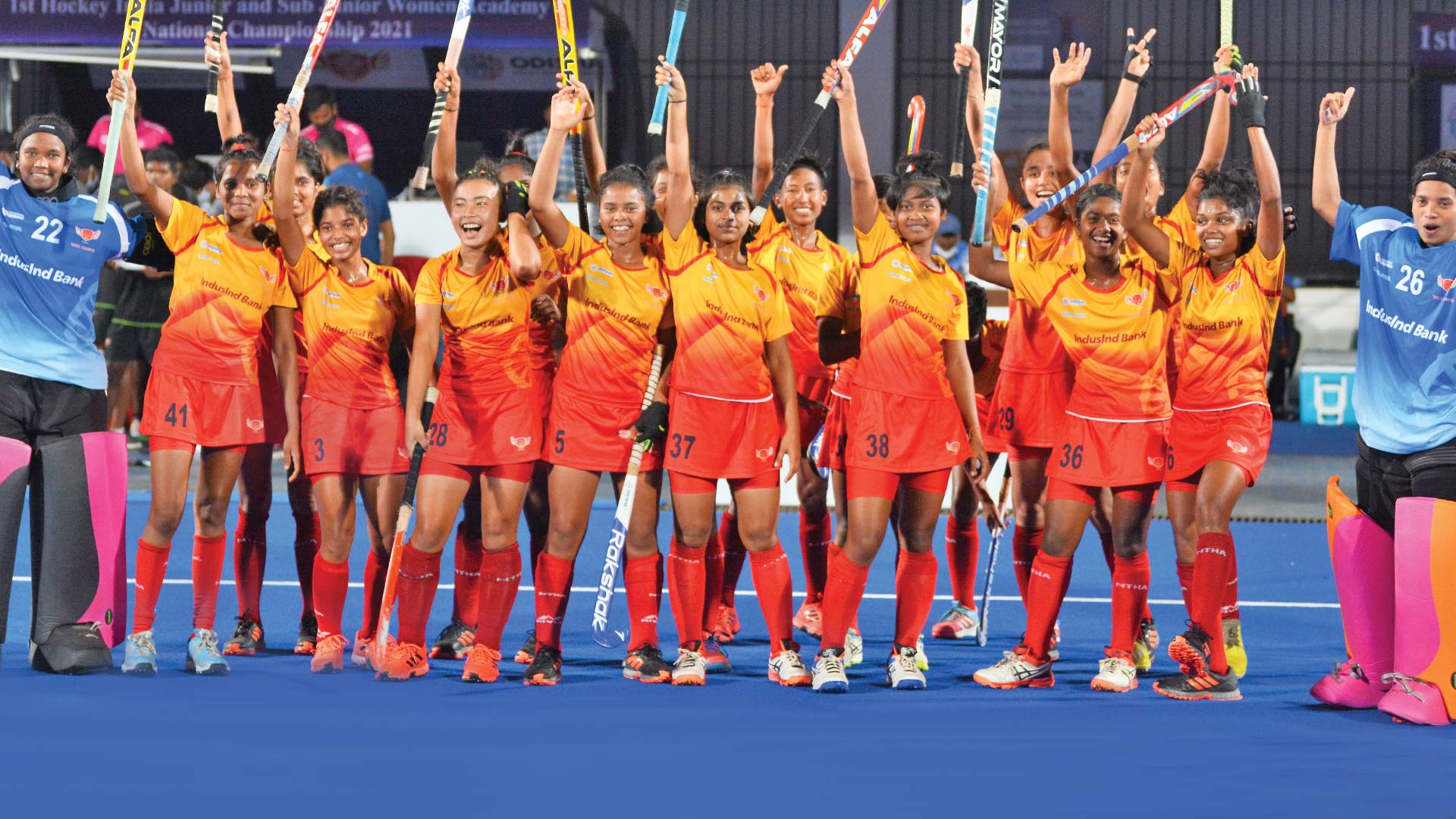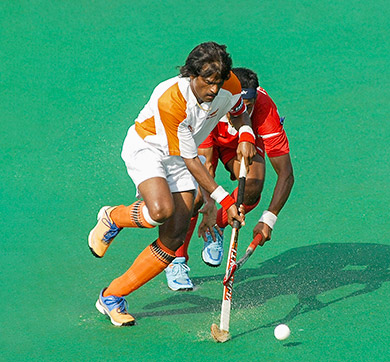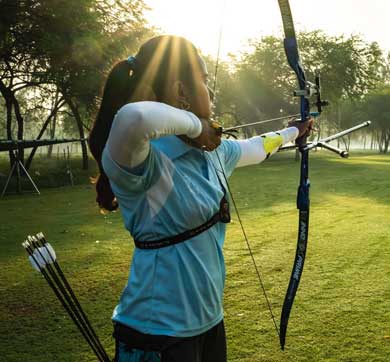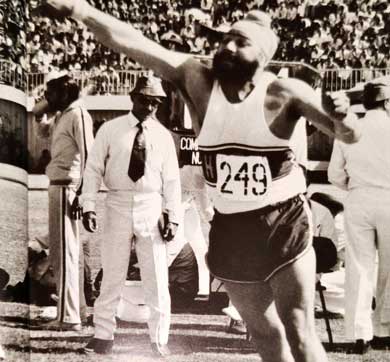June 2022 | 2361 words | 9-minute read
It was the medal that ended a drought of 41 years. The Indian men’s field hockey team came back from a two-goal deficit, defeating Germany 5-4 at the Tokyo Olympics in 2021 to win the bronze. India’s last Olympic medal in hockey was won at the Moscow Olympics in 1980. The Tokyo Olympics also saw the first Indian women’s hockey team make it to the bronze playoffs, missing the coveted podium finish by a whisker but winning a billion hearts. What India gained, and even missed, has whetted the nation’s appetite for the sport and accelerated its momentum.
Inextricably intertwined with India’s hockey story is the Tata hockey story, dating from 1928 — when India won her first Olympic gold medal in the sport — to the FIH Men’s Hockey World Cup 2023, which was held in Odisha with Tata Steel as an Official Partner.
From icons to grassroots
The Tata support to hockey was formalised at the Tata Sports Club (TSC) in the 1940s with members competing at all tiers of the sport. Did you know that at least five players in the Olympic gold-winning hockey teams were from the TSC? Lawrie Fernandes (TOMCO) and Leo Pinto (Tata Services) were on the team that won the 1948 gold. Randhir Singh Gentle (Tata Textiles) was on the teams that won golds in 1948, 1952 and 1956. Govind Perumal (TOMCO) was part of the 1952 and 1956 winning teams. MK Kaushik (TOMCO) was part of the team that won the gold in 1980.
The Tata group has not only continued to support elite hockey talents — like Dhanraj Pillay (Air India) and Clarence Lobo (Tata Power), who received the Dronacharya Award, India’s highest honour for sports coaches — but also taken the support to the grassroots to create the next generation of elite players.
Recognising the strong hockey culture in Jharkhand, the Tata Trusts, in 2016, integrated it into their education programme in the region to tackle the problem of school dropouts. This led to the development of a strong grassroots hockey programme focused on honing the inherent talent in the region and providing an opportunity for the children to dream big.
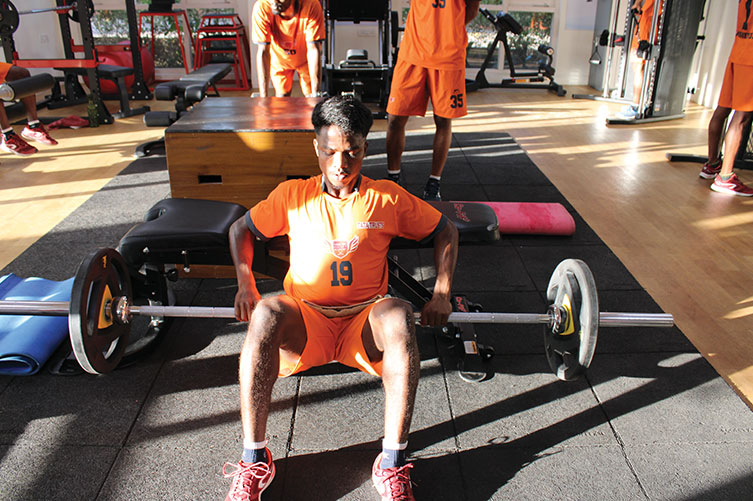
“We realised that if we were investing in developing talent or identifying talent from the grassroots, we also had to provide a pathway for them to excel and play at a competitive level,” says Neelam Babardesai, Head of Sports, Tata Trusts. “With that thought, we got into a partnership with Tata Steel in Jharkhand, and conceptualised the Hockey Ace Foundation (HAF), which would focus on nurturing talent from the rural tribal regions.”
HAF designed a three-tiered structure, along with technical partner Bovelander Hockey Academy (BHA), led by Dutch Olympian Floris Jan Bovelander. Through the programme, for the first time in India, quality, structured, international-level training began to be provided at the grassroots.
“We realised that if we were investing in developing talent or identifying talent from the grassroots, we also had to provide a pathway for them to excel and play at a competitive level.”—Neelam Babardesai, Head of Sports, Tata Trusts
The first tier is the after-school hockey training programme for boys and girls aged 8 to 13 from government schools. There are 70 grassroots centres in Jharkhand, of which 64 are run by Collectives for Integrated Livelihood Initiatives (CInI), a nodal agency of the Trusts, and six by the Tata Steel Foundation (TSF). The CInI-run centres have so far trained 5,265 boys and 4,860 girls, while the TSF-run centres have trained 175 boys and 55 girls.
Those with potential graduate to more focused, competitive training at two Regional Development Centres (RDCs) in Khunti or Simdega, the programme’s second tier. The RDCs are nonresidential hockey academies for players aged 12 to 17. Each RDC trains 50 boys and 50 girls. So far, 85 cadets from CInI-run RDCs have been placed at academies to pursue sports as a career option.
India's gold rush In 1928, the newly formed Indian Olympics Association, under the presidency of Sir Dorabji Tata, sent its first hockey team to the Olympics. India won her first gold that year, followed by golds in 1932 and 1936. The Tatas’ connection with hockey continued with JRD Tata, who nurtured the sport and many of its iconic players at TSC, and Naval H Tata, who was the first and longest serving president of the then Indian Hockey Federation; he also served on the International Hockey Federation and steered the All-India Council for Sports during its infancy — a legacy honoured by the Naval Tata Hockey Academy and the Odisha Naval Tata Hockey High Performance Centre. It led to the golden age of the game in the country, with India winning Olympic golds in 1948, 1952, 1956, 1964 and 1980. India also won the silver in 1960 and the bronze in 1968 and 1972. The 2021 bronze marked India’s 12th Olympic medal in the sport, making us the most successful men’s field hockey team at the Olympics.
“BHA gave us a standardised programme for training and evaluating the players’ progress, enabling a seamless transition of players from one level to another,” says Ms Babardesai.
A similar setup was launched in neighbouring Odisha in 2019 in a partnership between the Trusts, Tata Steel and the Government of Odisha. Odisha has 14 grassroots centres — eight in Sundargarh, two in Sambalpur, and one each in Deogarh, Dhenkanal, Ranpur and Chatrapur. Till date, 3,500 children have been trained in them. The Odisha government has now requested Tata Steel to run its grassroots programme through 22 new AstroTurf pitches laid by the government.
The grassroots centres act as feeders to the two RDCs located at government sports hostels in Rourkela and Sundergarh, where 145 male cadets and 90 female cadets are being trained. The initiative has also led to the introduction of a firstof-its-kind Grassroot League in Odisha.
These initiatives have tapped into the deep passion for hockey in the heartlands of Jharkhand and Odisha. The passion runs so deep that children play the game even on bumpy, uneven grounds, with brittle bamboo sticks in hand and cotton balls rolling across the ground. It is played with an enthusiasm usually reserved for cricket in the rest of the country. Many tribal youths from both states have become extraordinary players and given India some of her best hockey champions. The next, carefully built, tier in the Tata support for hockey creates a professional pathway for such talent.
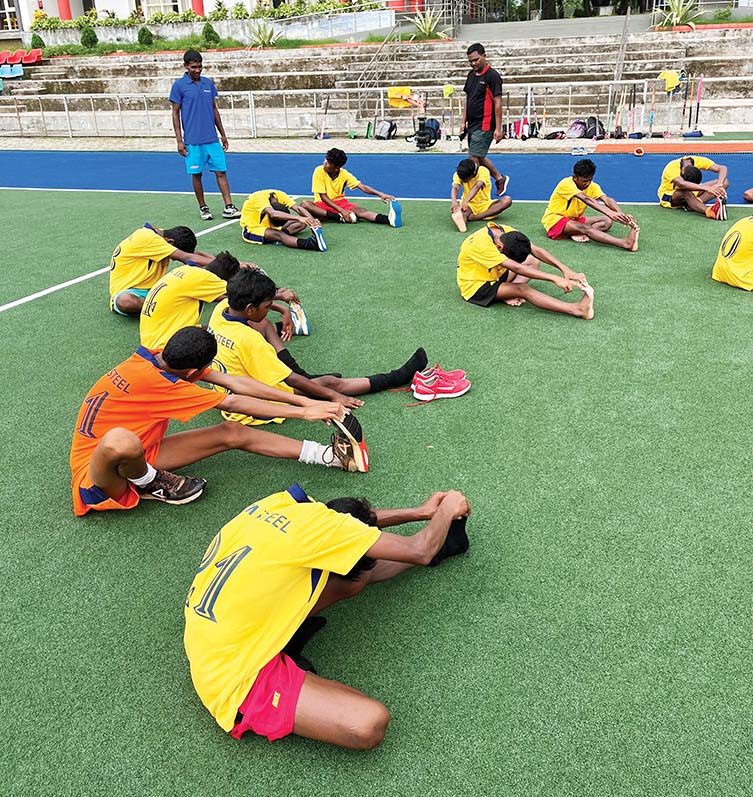
Creating champions
At the apex of the three-tier programme, sit the Naval Tata Hockey Academy (NTHA) in Jamshedpur and the Odisha Naval Tata Hockey High Performance Centre (ONTHHPC) in Bhubaneswar. Honouring Naval Tata’s enormous contribution to the sport, both are world-class residential hockey training facilities for cadets in the junior and sub-junior categories.
NTHA, established in 2017 by the Trusts and Tata Steel, started as a boys-only academy, with 26 cadets selected from the grassroots programme. ONTHHPC, a partnership between Tata Steel, Tata Trusts and the Odisha government, started in 2019 as a girls’ residency programme, with 30 cadets. The boys’ vertical was introduced in 2021, with 30 cadets.
Today, says Ashish Kumar, Chief Executive Officer, HAF, “We have a target of 104 cadets at NTHA, Jamshedpur, and 100 cadets at ONTHHPC, Bhubaneswar.”
Right resources
Both academies provide best-in-class sporting infrastructure, including AstroTurf, gym, swimming pool, medical rooms and sports science facilities. Cadets have access to the latest machines that analyse their performance. “NTHA offers highperformance coaching, using the tenets of sports science,” says Gurmeet Singh Rao, Project Director, NTHA, and a former professional hockey player. “Ours is the first hockey academy in India to have its own infrastructure.”
ONTHHPC, housed in the Kalinga Stadium, has the Abhinav Bindra Targeting Performance Centre, where cadets use a GPS gadget that provides data on their performance on the field, like distance, intensity, speed, endurance, etc. “We are probably the only hockey academy, other than the national team, to use this technology,” says Rajiv Seth, Project Director, ONTHHPC. “The programme has a huge impact as the young athletes get access to the best technology tools and high-class coaching to hone their skills to reach elite levels. A high-performance centre and academy of our repute has a significant role to play in grooming young athletes and helping them advance.”
“NTHA offers highperformance coaching, using the tenets of sports science. Ours is the first hockey academy in India to have its own infrastructure.”—Gurmeet Singh Rao, Project Director, NTHA, and a former professional hockey player
Cadets also get to work with top coaches, physiotherapists, sports scientists, strength and conditioning coaches, sports psychologists, masseurs, and nutritionists. The importance of this in moulding cadets cannot be overstated. “Our first batch of cadets were from remote areas, some without proper schooling and some were even deprived of two meals a day,” says Mr Kumar. “With support from our nutritionist, we educated them about the importance of nutrition, eating a balanced meal for a high-performance sport, etc. We educated them about the various aspects of training and how to integrate them into their daily routine.”
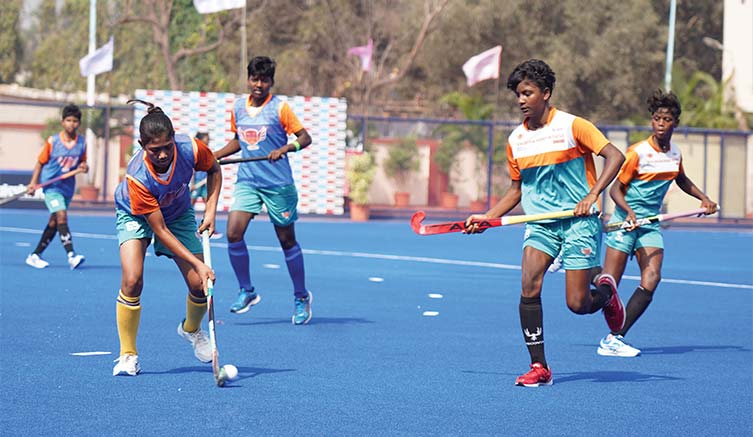
Making a difference
A parallel formal education is a core focus area for both academies. “We want to provide 360-degree development to our cadets,” says Mr Seth. “Our inputs go beyond hockey to developing their careers and their personalities. We look after their education completely.”
This is vital as many cadets hail from low-income families, some are school dropouts, and some have never been enrolled in a school. “The cadets come from remote areas so holistic development is important,” adds Mr Rao. “We also educate them on life skills like public speaking, overcoming stage fear, how to hold meetings, etc. NTHA’s first set of cadets will be out soon, and we understand that not everyone will be able to play professionally. Not all of them will make that mark, but when they walk out of the academy they should be capable and independent enough to start their careers and life.”
“We want to provide 360-degree development to our cadets. Our inputs go beyond hockey to developing their careers and their personalities. We look after their education completely.”—Rajiv Seth, Project Director, ONTHHPC
The impact of this philosophy is felt at the grassroots as well. “In 2018, I met the children at a grassroots tournament, and they were shy, unwilling to make eye contact,” says Ms Babardesai. “Two years later, when I visited for another tournament, I could see the difference.
The same children were smiling, making eye contact, speaking confidently. They are more attentive and responsible at school. They learn healthy life habits that can improve the quality of their lives. That is the strength of the programme.”
On the road to success
“Our ultimate aim is to produce quality players through structured and scientific training and make NTHA and ONTHHPC the premier hockey academies of India with the intention of having maximum representation at the state and national levels,” says Mr Kumar.
The efforts have already yielded success. The NTHA team has participated in major national tournaments, often winning a trophy. This has increased their exposure, and cadets have been picked to play in state and corporate teams. Going ahead, NTHA plans to take the junior team to an international tournament. Also on the cards, are plans to attend camps by other academies, which are hunting grounds for coaches from corporate sports departments. “Three years ago, our target was to have one NTHA player on the Indian team,” says Mr Rao. “We are very close to it. One of our cadets has been shortlisted for the junior India camp. We also have 30 national medallists in our academy right now.”
Coaching the coaches Faculty development is key to building a professional academy. Coaches in all three tiers are accredited to ensure high standards of coaching. NTHA has a Fédération Internationale de Hockey (FIH) Level 3 coach, the topmost level; there are only 11 Level 3 coaches in India. The main coaches at ONTHHPC are accredited FIH Level 1 and Level 2 coaches. Assessments and training courses are conducted every quarter to upgrade their skills and train them to spot talent. The ecosystem is structured in such a way that skilled players who don’t qualify for the academies are also exposed to coaching as a career option.
Six ONTHHPC girl cadets are part of the junior national camp; four have made their international debuts in the junior category and one has been picked for the senior national team. Almost 75% of the cadets, boys and girls, play for state teams. “Both the girls and boys, across categories, have been part of teams that won a slew of medals — five silvers and seven bronzes — at national championships. Seven of our girl cadets were also part of the team that won the gold at the Mirnawan Cup 2022,” says Mr Seth.
The wins prove that HAF’s efforts to professionalise hockey at the grassroot are bearing fruit. The foundation was recently awarded the Hockey India President Award for Outstanding Achievement in 2022 at the Hockey India Annual Awards.
“We believe in the power of sports to inspire and unite communities, and our state-of-the-art hockey academy and high-performance centre reflect our dedication to nurturing young talent at the grassroots level in Jharkhand and Odisha,” says Chanakya Chaudhary, Chairman, Hockey Ace Foundation, and Vice President, Corporate Services, Tata Steel. “By providing access to quality infrastructure, training, and coaching, we empower aspiring hockey players from all backgrounds to realise their full potential and develop essential qualities of sportsmanship and teamwork that will serve them well on and off the field. Tata Steel’s history with the sport runs deep, and we will continue to strive towards building a bright future for Indian hockey going forward.”
—Cynthia Rodrigues




